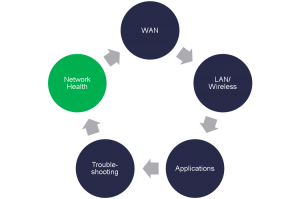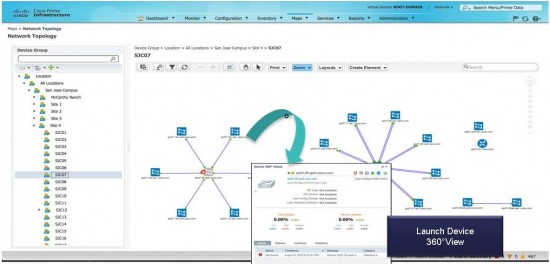Last week, I concentrated on how to use Cisco Prime Infrastructure to do troubleshooting for your network. Today, as the 5th and final post of my 5-part blog series, I’ll look at how to maintain network health for your branch site users with Prime. As a quick recap, here’s my blog series on how to set up networking with Prime for a new branch site.
| WAN deployment – blog 1 Converged wired and wireless – blog 2 Application performance – blog 3 Troubleshooting – blog 4 Network health – blog 5 (this blog) |
 |
As designed, you have successfully brought up your new branch site and the network is now in production. And you are well prepared to troubleshoot if anything goes wrong. Before you declare “mission accomplished”, there is one more step you can take to achieve long-term success. Just like preventive healthcare can help a person to stay healthy, Prime gives you a number of tools to monitor and maintain your network health. By making full use of these tools, you are prepared to address potential issues before they impact your network.
With Prime, you can
– Keep track of network changes with network topology maps and Device 360° Views;
– Maintain centralized visualization across multiple Prime instances with Operations Center ; and
– Stay engaged with Cisco support integration.
One of the things that always excites network engineers and managers is an accurate network topology map. Prime Infrastructure can provide such a map for you, which includes all your branch sites and main campus site. If there are any changes, you’ll know right away. Or, if you want to know more details, you can drill down to each networking device with Prime Device 360° View. The chart below shows a portion of Cisco’s production network topology map.

If you have a large network with many sites, you may have deployed more than one instance of Cisco Prime Infrastructure to manage your network for scalability and resiliency. With Prime Operations Center, you can manage all these instances together as one.

Configuration, asset, client, and event details remain stored with individual instances. Operations Center gives you a searchable, central view of assets, alarms, and clients associated with up to 10 Prime Infrastructure instances. Operations Center also gathers and presents alarms from all instances into a single pane or pop-up window and for you to monitor your network health tracked by each instance. With one click, you can drill down to any instance to begin troubleshooting.
A useful Prime capability enjoyed by many of our customers is Cisco support integration. Without having to launch another web browser to initiate online support, Prime has built-in support so that you can get connected with Cisco TAC or Cisco Support Community directly. You can open a case, track case status, or join community discussions, all from one place. You stay engaged with Prime.

Proactive network health support. This is what you can get from Prime Infrastructure. Prime makes network health an easy task.
This is my last post on how Prime can help you to set up networking for a new branch site. I’ll leave the following thought with you as I conclude this blog series.
Your company has great initiatives such as expanding business with a new branch site. Cisco Prime Infrastructure helps you support these initiatives. With Prime, you can
– grow business opportunities with rapid IWAN, Converged Access and other networking deployments;
– lower business costs with application assurance and efficient troubleshooting;
– reduce business risks by minimizing downtime with network health support.
Cisco Prime Infrastructure makes simplified network deployments and proactive network operations an easy task for you.
Join the Conversation
Follow us @CiscoEnterprise.
Visit the Enterprise Networks Communities.


CONNECT WITH US